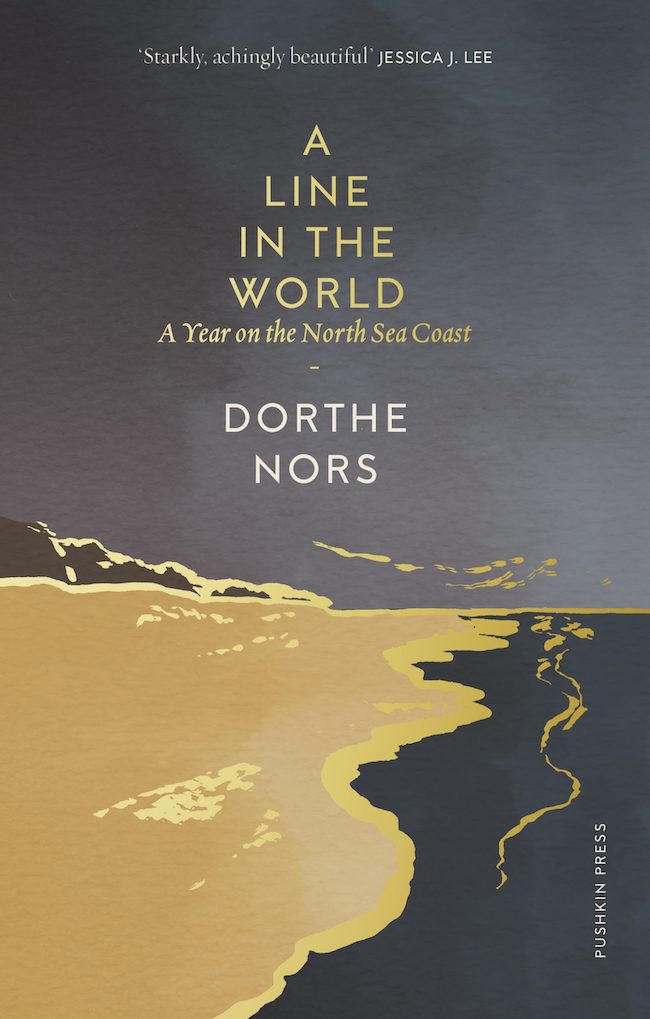The landscapes of Dorthe Nors’ ‘A Line in the World’ — a story of shipwrecks and storm surges, cold-water surfers, sun-creased beach mums and resolute sailor’s wives — persist in the memory as a painterly afterglow, writes Steven Lovatt.

Here’s an odyssey along Europe’s north-western shore, a journey through outer and inner landscapes by Danish novelist and short-story writer Dorthe Nors that seems to have occasioned all kinds of personal reckoning: with her cultural heritage, her native land, the climate emergency, above all with her own place in the world as a woman in mid-life, an outsider and a writer.
Early on, Nors states her intention to be ‘open to the truth that arises between me and the place, at the moment we meet’, a methodology which gives fair notice of the book’s open-ended, somewhat improvised feel. It’s a half-contrived sketchbook of encounters and reflections, a cleverly arranged and selectively spot-lit picture of what for most British readers will be a previously unimagined part of the world — a landscape of dunes, wind-whetted islands and low waterlogged peninsulas that persists in the memory as a painterly afterglow.
A landscape is an eyeful of the world’s surface pre-marinated in stories, and much of the book comprises adroitly repurposed narratives collected by Nors on her journey. She has the short story teller’s gifts of abbreviation and compression, often employing them to layer time so that human meaning is set against much vaster scales:
Sediment deposited in the Ice Age continues all the way down to the water’s edge; the dunes have verdant skin. On the beach, there are preparations for a Midsummer’s Eve bonfire. Some children, it must have been, have made a witch with stiff broomstick arms and a wild look in her felt-tip eyes.
As here, most of the landscapes Nors describes contain human beings, if only implicitly. Yet the reverse is also true, and Nors conveys with subtlety and compassion that people are also vessels of their landscapes. This is nowhere clearer than in the frequent autobiographical passages; much of the book’s emotional depth comes from its author meeting herself in the landscapes of her childhood, and finding both place and person changed: ‘You carry the place you come from inside you, but you can never go back to it.’
Both personal and social resilience are required, for if anything is permanent in the relationship between these places and their people, it’s the latter’s transience and vulnerability. The precarity, over centuries, of life on this coast — the shipwrecks, deadly storms, mass drownings — is emphasised far beyond what’s required of a theme. To hazard civilisation here, to tempt the maelstrom with human structures and rationales, though certainly it breeds tenacity, is also to live figuratively as well as literally on the edge.
And Nors herself is a compellingly unpredictable figure. It’s rare to find a persona at once so confessional and so reticent, and here in particular we see the techniques of a fiction writer enliven what could have been a clichéd walk along a picturesque coastline. I’m fascinated by the unexpected violence with which Nors describes travelling and writing. The gentle intention to open herself to encounters is belied by her insistence that she must ‘meet the landscape like a bullet through flesh. Penetrate’, and she compares writing about landscape to making a scalpel cut. There’s also a recurrent fascination with self-annihilation, and of her superfluousness both to nature and human society. We’re offered some reasons for this. Her family home was razed to accommodate a motorway, and in fact she is multiply displaced: although she has roots in this landscape, she still doesn’t belong, as the locals make clear. Of course finally it’s none of our business; it’s enough to appreciate what an eccentric eye, allied to a powerful literary gift, makes possible in the way of beauty, insight and enjoyment. For though melancholy is present, it’s never self-pitying, and the emotional range of the book is very broad, being variously tender, phlegmatic, sceptical and mordantly deadpan.
It’s also a beautifully written book — and great credit is due to Caroline Waight for her translation. Nors can fix a scene with one detail, and she’s expert at the kind of elemental, goosebump-inducing metaphors that were the trademark of Tomas Tranströmer. Two idiosyncrasies of Nors’ style — her shunting of the grammatical subject to the back of the sentence and her seemingly needless repetition of the subject across sentences — have the cumulative effect of slowing the narrative, making it spin in eddies. At times, indeed, it is as though we are briefly adrift in her voice alone, watching as fragments of could-be narratives bob past us, until one of them sticks and Nors embarks on another compelling story.
‘The order of our little world is gone,’ she writes ‘As though washed into the sea.’ She speaks what many of us presently feel, yet by the very fact of its existence, and the spiritual food and intellectual entertainment it provides, A Line in the World testifies to the value of what endures.
*
‘A Line in the World: A Year on the North Sea Coast’ is just-published by Pushkin Press. Buy a copy here (£16.13).
Steven Lovatt wrote ‘Birdsong in a Time of Silence’ and edited ‘An Open Door: New Travel Writing for a Precarious Century’. He reviews for The Friday Poem and does freelance copyediting from his home in Swansea.